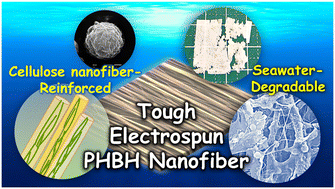Seawater-degradable, tough, and fully bio-derived nonwoven polyester fibres reinforced with mechanically defibrated cellulose nanofibres†
Abstract
Developing nonwoven fabrics using sustainable materials is necessary to alleviate marine plastic pollution. Poly(3-hydroxybutyrate-co-3-hydroxyhexanoate) (PHBH) has attracted attention because it undergoes natural degradation, particularly in the ocean. Electrospun PHBH nonwoven fabrics have limited applications owing to poor mechanical properties. Although the use of cellulose nanofibres (CNFs) as fillers can potentially result in enhancement of the mechanical properties of PHBH nonwoven fabrics, their low dispersibility in CHCl3, a good solvent for PHBH, hinders the direct electrospinning of CNF-containing PHBH. Herein, nonwoven fibres were fabricated directly by electrospinning Pickering emulsions stabilized with mechanically defibrated CNFs. The CNFs were found to be encapsulated in the core of the PHBH fibres. CNF-reinforced fibres showed excellent toughness, approximately 11 and 22 times greater than those of PHBH films and CNF-free PHBH fibres, respectively. These also underwent complete and very rapid degradation in seawater (7–10 d), compared to the PHBH film (14–40 d). The proposed CNF-reinforced PHBH is a seawater-degradable bioplastic containing complete biomass-derived components.



 Please wait while we load your content...
Please wait while we load your content...